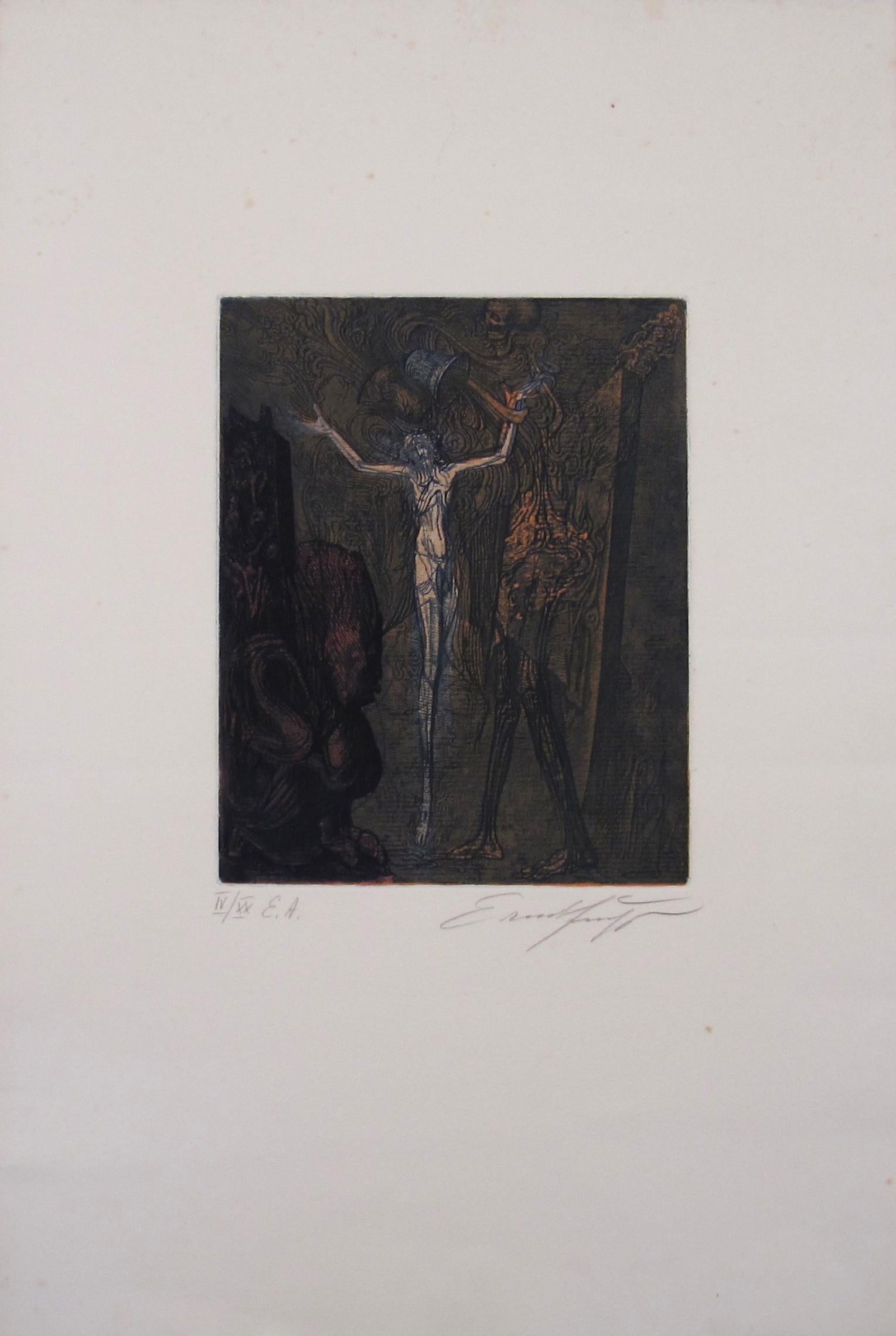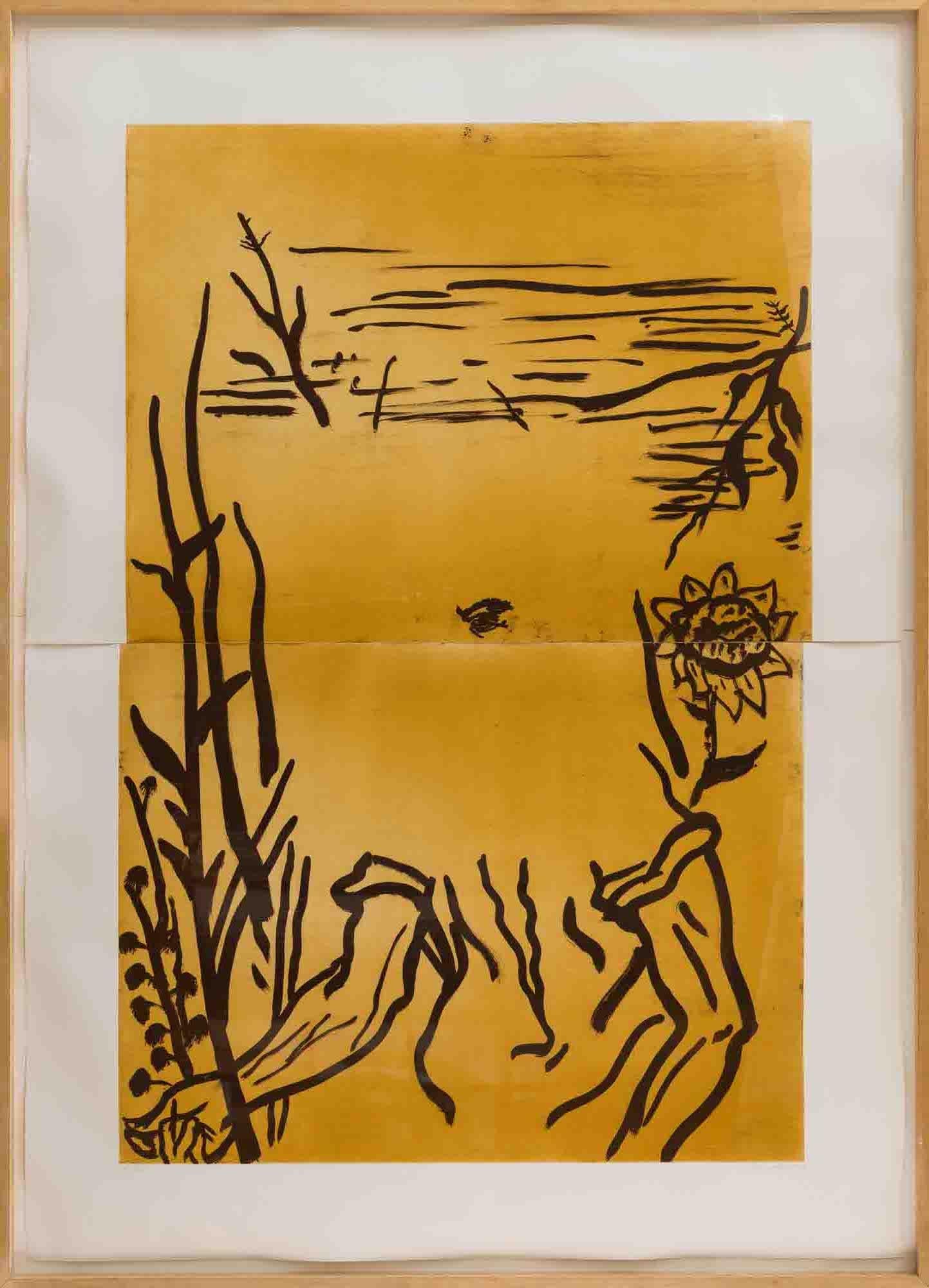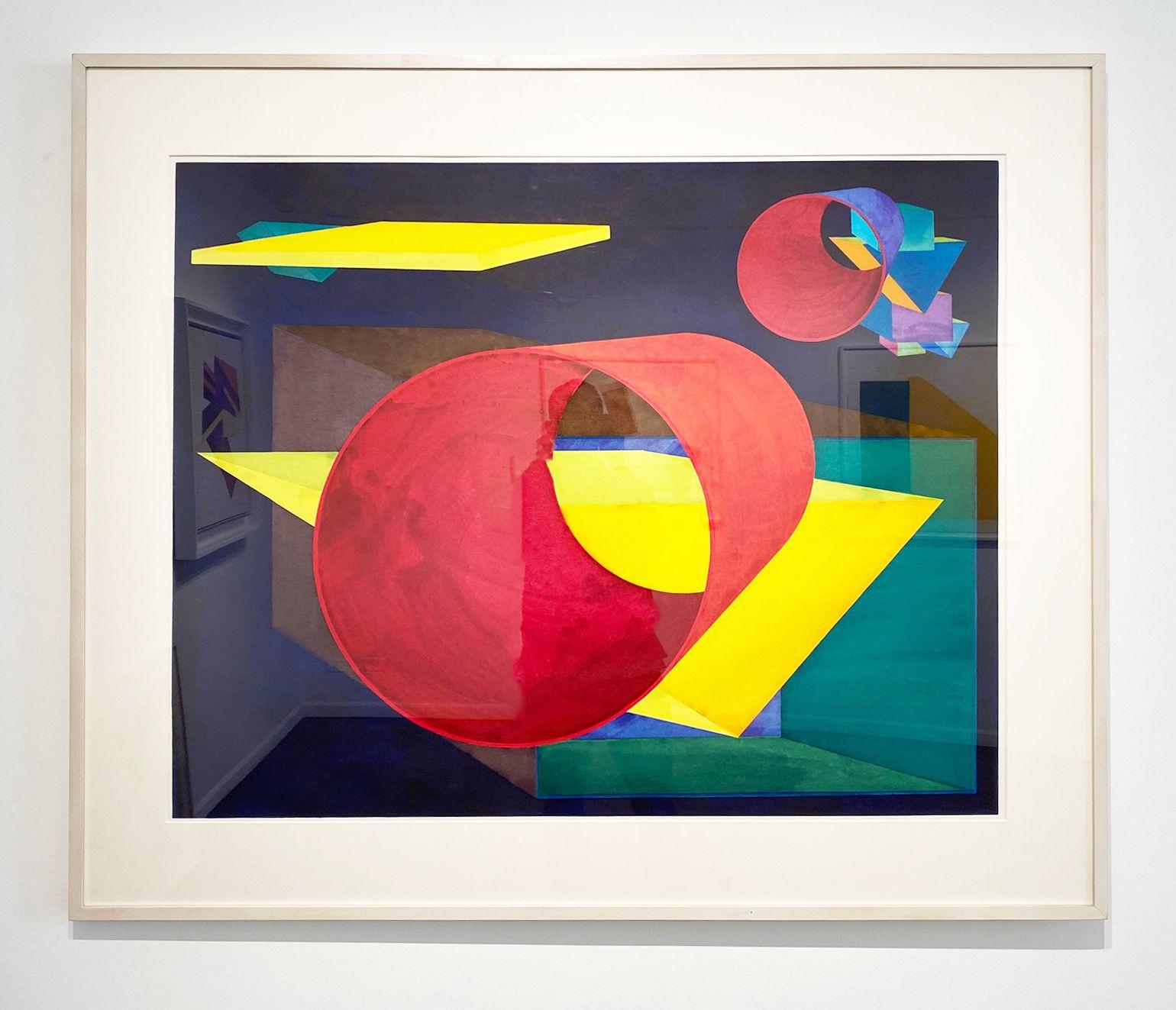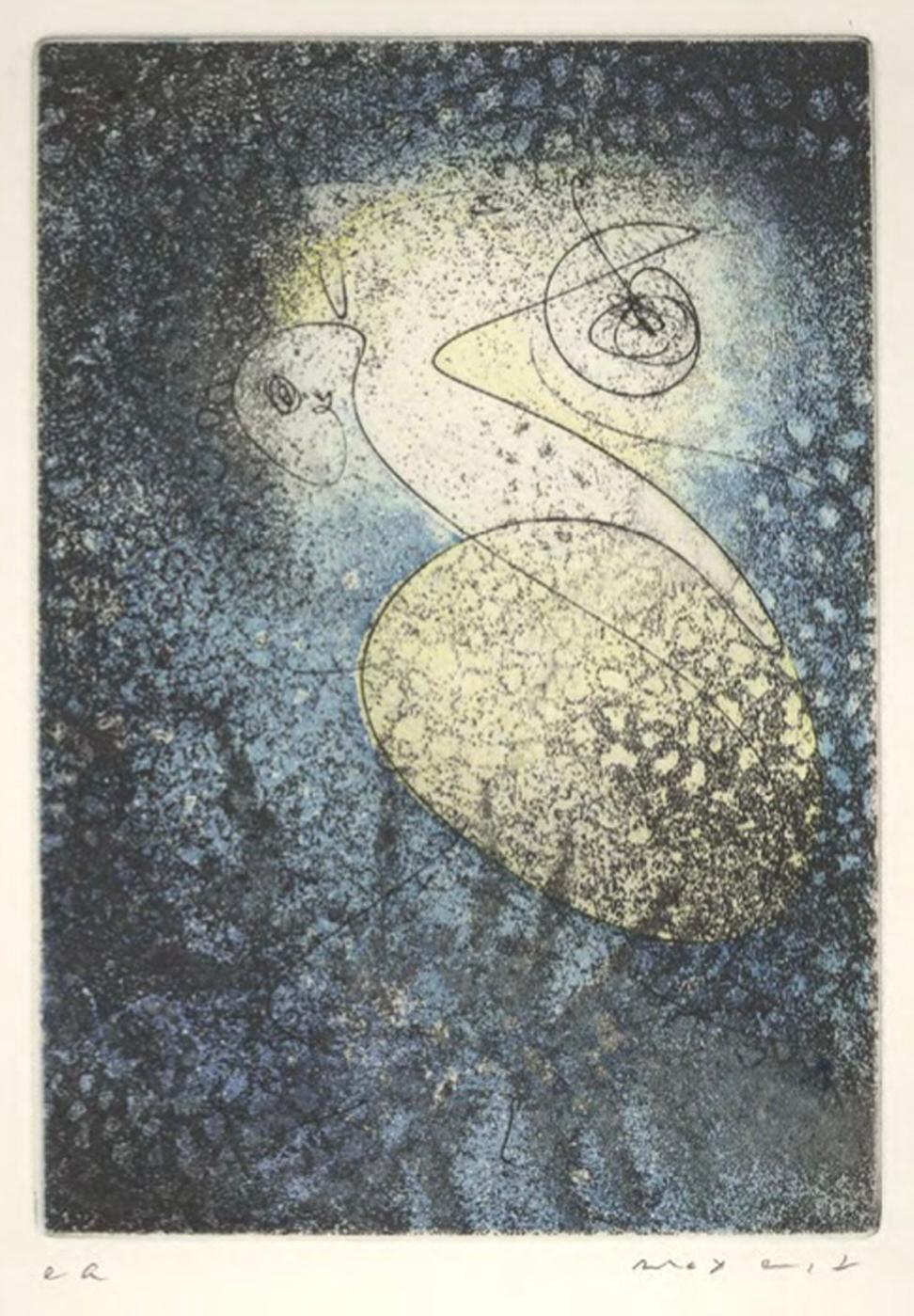Items Similar to “Untitled”
Want more images or videos?
Request additional images or videos from the seller
1 of 10
Ferdinand Springer“Untitled”1951
1951
About the Item
Original aquatint etching “Untitled” by the Germans artist, Ferdinand Springer. Signed in lower right margin in pencil by the artist and dated 1951. Condition is excellent. Edition size in pencil in lower left margin 98/200. Sheet size (full) is 115 by 22.75. Image size is 9.75 by 18.75. The artwork is housed in a thin antique silver contemporary frame. Overall framed measurements are 19.5 by 27 inches. Under glass. Provenance: A St. Petersburg, Florida collector.
Ferdinand Springer, painter and printmaker, was born to a German father and a Swiss mother in Berlin on October 1, 1907. After graduating from high school in Potsdam, he studied art history at the University of Zurich. He began painting in 1927 and visited Milan where he met the Italian painters Giorgio Morandi and Carlo Carrà.
Springer moved to Paris in 1928 where he studied with Roger Bissière at the Académie Ranson. In 1932, he learned intaglio techniques at Atelier 17 in Paris and, in 1937, he traveled to New York where he exhibited at the Julian Levy Gallery. During this time he met Alexander Calder and Salvatore Dali. Springer’s wife was Jewish and his father wanted him to sign papers denouncing her to the Nazi government which he refused to do. After moving to Grasse in southern France in 1939, Springer was interned by the Nazis, along with Max Ernst, Hans Bellmer and Otto Wols at the Camp des Milles near Aix-en-Provence.
After his release in 1940, Springer returned to Grasse and started the “Grasse Group” with Hans Arp, Sonia Delaunay, Alberto Magnelli and others, and produced his first abstract works. With the escalation of the war Springer escaped to Switzerland in 1942 but was not allowed to exhibit his work. He returned to Grasse in 1945 to discover that of most his work was lost.
In 1946, Springer created engravings for Paul Valery’s Eupalinos VI, and in 1952 he relocated to Paris and returned to painting in 1955. He resettled in Grasse in 1960 and became a pioneer in the revival of printmaking, along with Johnny Friedlander, Pierre Courtin, and Henri-Georges Adam. He continued to work and to exhibit throughout Europe and the United States, and in the early 1990s began focusing on painting large canvases.
A retrospective of Springer’s oil paintings, watercolors, drawings, engravings, tapestries, and sculptures, created between 1929 and 1967, was presented at the Kunstverein Heidelberg in 1967. That same year, André Malraux, as Government Minister of France, awarded Springer the medal Chevalier des Arts et des Lettres.
Springer's work is represented in the collections of the Kunstmuseum, Basel; the Kunstmuseum, Bern, Switzerland; the Kunsthalle Bremen, Germany; the Brooklyn Museum, New York; the Fogg Art Museum, Cambridge, Massachusetts; the Cincinnati Art Museum, Ohio; the Yale University Art Gallery, New Haven, Connecticut; the Museum of Modern Art, New York; the Musée National d'Art Moderne, Paris; the Bibliothèque nationale de France, Paris; the Musée des Beaux-Arts, Rouen; the Fine Arts Museums of San Francisco, California; the Library of Congress, Washington, D.C.;
Ferdinand Springer died on 31 December 1998 in Grasse, France.
- Creator:Ferdinand Springer (1907 - 1998, German)
- Creation Year:1951
- Dimensions:Height: 15 in (38.1 cm)Width: 22.75 in (57.79 cm)Depth: 1 in (2.54 cm)
- Medium:
- Movement & Style:
- Period:
- Condition:Ever so slight wrinkling of paper. Artwork is mounted full sheet.
- Gallery Location:Southampton, NY
- Reference Number:1stDibs: LU14111826362
About the Seller
4.9
Platinum Seller
These expertly vetted sellers are 1stDibs' most experienced sellers and are rated highest by our customers.
Established in 1977
1stDibs seller since 2013
464 sales on 1stDibs
Typical response time: 1 hour
- ShippingRetrieving quote...Ships From: Sarasota, FL
- Return PolicyA return for this item may be initiated within 7 days of delivery.
More From This SellerView All
- “Untitled” (from the Lezard aux Plumes d’Or series)By Joan MiróLocated in Southampton, NYColored lithograph on archival paper by Joan Miro. Part of the “Lizard with the Golden Feathers series. Signed in pencil “Miro” lower right. “H.C.” lower left. (See details below) ...Category
1970s Modern Abstract Prints
MaterialsArchival Paper, Lithograph
- “Shore Sentry”By Syd SolomonLocated in Southampton, NYShore Sentry, is an original color, limited edition lithograph on handmade German black etching paper; printed by Topaz Editions in 1977. Artist proofs 10. Edition size 100. Provenance:: A Sarasota, Florida collector Signed: Artist signed lower left with edition size Image size: 22 by 30 inches Sheet size: 30 by 38 inches Edition 38/100 Condition: Excellent Overall framed size: 30.25 by 38.25 inches Framed under plexiglass in chrome colored metal gallery frame SYD SOLOMON BIOGRAPHY Written by Dr. Lisa Peters/Berry Campbell Gallery “Here, in simple English, is what Syd Solomon does: He meditates. He connects his hand and paintbrush to the deeper, quieter, more mysterious parts of his mind- and he paints pictures of what he sees and feels down there.” --Kurt Vonnegut Jr. from Palm Sunday, 1981 Syd Solomon was born near Uniontown, Pennsylvania, in 1917. He began painting in high school in Wilkes-Barre, where he was also a star football player. After high school, he worked in advertising and took classes at the Art Institute of Chicago. Before the attack on Pearl Harbor, he joined the war effort and was assigned to the First Camouflage Battalion, the 924th Engineer Aviation Regiment of the US Army. He used his artistic skills to create camouflage instruction manuals utilized throughout the Army. He married Ann Francine Cohen in late 1941. Soon thereafter, in early 1942, the couple moved to Fort Ord in California where he was sent to camouflage the coast to protect it from possible aerial bombings. Sent overseas in 1943, Solomon did aerial reconnaissance over Holland. Solomon was sent to Normandy early in the invasion where his camouflage designs provided protective concealment for the transport of supplies for men who had broken through the enemy line. Solomon was considered one of the best camoufleurs in the Army, receiving among other commendations, five bronze stars. Solomon often remarked that his camouflage experience during World War II influenced his ideas about abstract art. At the end of the War, he attended the École des Beaux-Arts in Paris. Because Solomon suffered frostbite during the Battle of the Bulge, he could not live in cold climates, so he and Annie chose to settle in Sarasota, Florida, after the War. Sarasota was home to the John and Mable Ringling Museum of Art, and soon Solomon became friends with Arthur Everett “Chick” Austin, Jr., the museum’s first Director. In the late 1940s, Solomon experimented with new synthetic media, the precursors to acrylic paints provided to him by chemist Guy Pascal, who was developing them. Victor D’Amico, the first Director of Education for the Museum of Modern Art, recognized Solomon as the first artist to use acrylic paint. His early experimentation with this medium as well as other media put him at the forefront of technical innovations in his generation. He was also one of the first artists to use aerosol sprays and combined them with resists, an innovation influenced by his camouflage experience. Solomon’s work began to be acknowledged nationally in 1952. He was included in American Watercolors, Drawings and Prints at the Metropolitan Museum of Art, New York. From 1952–1962, Solomon’s work was discovered by the cognoscenti of the art world, including the Museum of Modern Art Curators, Dorothy C. Miller and Peter Selz, and the Whitney Museum of American Art’s Director, John I. H. Baur. He had his first solo show in New York at the Associated American Artists Gallery in 1955 with “Chick” Austin, Jr. writing the essay for the exhibition. In the summer of 1955, the Solomons visited East Hampton, New York, for the first time at the invitation of fellow artist David Budd. There, Solomon met and befriended many of the artists of the New York School, including Jackson Pollock, Franz Kline, Willem de Kooning, James Brooks, Alfonso Ossorio, and Conrad Marca-Relli. By 1959, and for the next thirty-five years, the Solomons split the year between Sarasota (in the winter and spring) and the Hamptons (in the summer and fall). In 1959, Solomon began showing regularly in New York City at the Saidenberg Gallery with collector Joseph Hirshhorn buying three paintings from Solomon’s first show. At the same time, his works entered the collections of the Whitney Museum of American Art, the Solomon R. Guggenheim Museum, and the Wadsworth Athenaeum in Hartford, Connecticut, among others. Solomon also began showing at Signa Gallery in East Hampton and at the James David Gallery in Miami run by the renowned art dealer, Dorothy Blau. In 1961, the Guggenheim Museum’s H. H. Arnason bestowed to him the Silvermine Award at the 13th New England Annual. Additionally, Thomas Hess of ARTnews magazine chose Solomon as one of the ten outstanding painters of the year. At the suggestion of Alfred H. Barr, Jr., the Museum of Modern Art’s Director, the John and Mable Ringling Museum in Sarasota began its contemporary collection by purchasing Solomon’s painting, Silent World, 1961. Solomon became influential in the Hamptons and in Florida during the 1960s. In late 1964, he created the Institute of Fine Art at the New College in Sarasota. He is credited with bringing many nationally known artists to Florida to teach, including Larry Rivers, Philip Guston, James Brooks, and Conrad Marca-Relli. Later Jimmy Ernst, John Chamberlain, James Rosenquist, and Robert Rauschenberg settled near Solomon in Florida. In East Hampton, the Solomon home was the epicenter of artists and writers who spent time in the Hamptons, including Alfred Leslie, Jim Dine, Ibram Lassaw, Saul Bellow...Category
1970s Post-Modern Abstract Prints
MaterialsHandmade Paper, Lithograph
- "Untitled"By Nahum TschacbasovLocated in Southampton, NYOriginal engraving, aquatint, intaglio on archival paper. Signed and dated lower right, 1947. Artist proof. Condition: Good. Provenance: Estate of the artist. Image size 6.75 by 5...Category
1940s Surrealist Figurative Prints
MaterialsArchival Paper, Engraving, Aquatint, Intaglio
- "Untitled"By Nahum TschacbasovLocated in Southampton, NYOriginal artist proof engraving, aquatint, intaglio on archival paper by the Russian/American artist, Nahum Tschacbasov. Signed in pencil lower right and dated 1947. Condition: good...Category
1940s Surrealist Figurative Prints
MaterialsArchival Paper, Engraving, Aquatint, Intaglio
- “On the Seine, Paris”By Hans FiguraLocated in Southampton, NYOriginal aquatint etching of working river barges on the Seine in Paris, France. A horse drawn cart is seen loading or unloading product. Circa 1900. Si...Category
Early 1900s Academic Landscape Prints
MaterialsArchival Paper, Aquatint
- “The Bird”By Nahum TschacbasovLocated in Southampton, NYHand colored original artist proof etching by the well known Russian/American artist Nahum Tschacbasov. Marked “AP” lower left for artist proof in pencil. Signed by the artist lower...Category
1940s Modern Figurative Prints
MaterialsEtching, Archival Paper
You May Also Like
- Ernst Fuchs Jesus Crucifixion Aquatint Vienna Fantastic Realism Austria 1972By Ernst FuchsLocated in Meinisberg, CHErnst Fuchs (Austrian, 1930 - 2015) Jesus speaking from the cross A rare Artist proof sheet from the Folio “Jean Paul. Die Rede des toten Christus vom Weltgebaude herab, dass kein Gott sei”, published in 1972 by Propyläen, Berlin, Germany. • Aquatint etching on French Arches paper (watermarked) • Sheet ca. 57 x 38 cm • Plate, ca. 24.7 x 19.7 cm • Signed bottom right • Inscribed in pencil bottom left: IV/XX E. A. (Print No. 4 out a run of twenty, Épreuve d'artiste (Artist’s proof) Worldwide shipping is complimentary - There are no additional charges for handling & delivery. Ernst Fuchs was an Austrian painter...Category
1970s Surrealist Abstract Prints
MaterialsInk, Archival Paper, Aquatint
- Infinite EternalLocated in New York, NYA 6"x 6" etching on a 11"x 15" paper, made by the Artist in a limited edition of 6 Framing + 75$ About the Series: Gilliam began the series Life Lines in 2017 after recently coming ...Category
2010s Abstract Prints
MaterialsEtching, Aquatint, Archival Paper
- Untitled from BROOKLYN ACADEMY OF MUSIC 1986-87By Julian SchnabelLocated in Saint Louis, MORising to prominence in the late 1970s and early 1980s, American artist Julian Schnabel is known for a multidisciplinary practice that spans painting, sculpture and film. During his ...Category
1980s Abstract Prints
MaterialsArchival Paper, Aquatint
- RUSSELL'S WAYBy Al HeldLocated in Three Oaks, MIIn excellent condition from an edition of 50, this piece is beautifully framed in museum-quality materials. Al Held is best remembered for his large-scale paintings of bright, hard-e...Category
1880s Abstract Expressionist Abstract Prints
MaterialsArchival Paper, Etching, Aquatint
- Untitled 1965 #107A Surrealist - Etching & Aquatint in colors Blue Yellow BlackBy Max ErnstLocated in Rancho Santa Fe, CAMax Ernst "Untitled" 1965 Etching and aquatint in colors, on Arches paper. 7.8 x 5.39 inches Publisher: Georges Visat, Paris. Total edition: 100 copies +EA. Publication: Spies - Lepp...Category
1960s Surrealist Abstract Prints
MaterialsArchival Paper, Etching, Aquatint
- Seven Sculpture Ideas I - ETCHING, AQUATINT and ROULETTE in TEN COLORSBy Henry MooreLocated in Rancho Santa Fe, CASeven Sculpture Ideas I (Cramer 589) Etching, aquatint and roulette in 10 colors, 1982, on Arches, signed in pencil. 39/50 From the numbered edition of 50. Published by The Raymond ...Category
1980s Surrealist Abstract Prints
MaterialsArchival Paper, Etching, Aquatint
Recently Viewed
View AllMore Ways To Browse
Antique Spring
Albertos Antiques
Bibliotheques Vintage
Vintage Florida Glasses
Camp High
Vintage St Medals
Ferdinand Vintage
Massachusetts Antiques
Modern Tapestries With Frame
Large Intaglios
Silver Frame Etching
St Petersburg Florida
Connecticut Antique
Paul Julian
Etchings In Silver Frame
Dali Drawing Original
Antique Sign Library Sign
Morandi Artist





